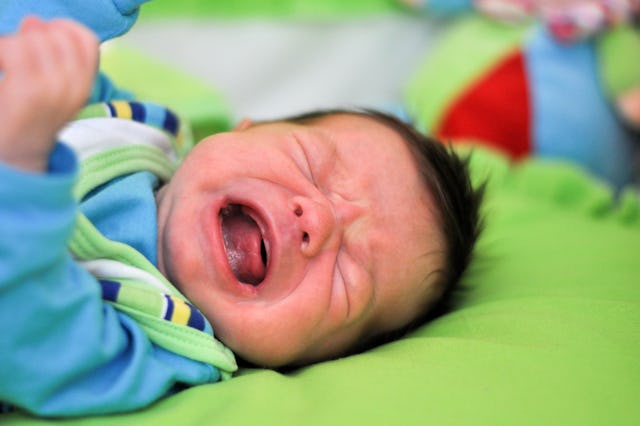Sorry, But A New Study Shows That Infant Crying Totally Does Not Peak At 6 Weeks
Everything you’ve heard about the ‘cry curve’ is probably wrong.

If, as a new parent, you’ve googled, “Why is my baby crying?” you’re not alone — a recent poll shows that 38% of people do the same during the first year of their child’s life. If you’ve also wondered, How long will this go on? again, you’re in good company. Many a bleary-eyed, desperate parent has held a shrieking infant in one hand while using the other to search the internet for reassurance that their baby’s crying won’t last forever.
Up until now, most of these searches have led parents to a theory known as the ‘cry curve.’ Based on data collected from a U.S. study in 1962, the graph forms a recognizable mountain shape, predicting that babies’ crying will peak at around 6 weeks and then decrease, stabilizing at a survivable-looking level around 3 months. What this curve communicates to parents is that it’s normal for a compliant, sleepy newborn to become a defiant, wailing infant, and that there is, indeed, a light at the end of the tunnel.
But a new analysis from Aarhus University in Denmark calls the ‘cry curve’ into question. Scientists looked at 57 research articles about infant crying from 17 different countries and modeled all the data to see if it fits the ‘cry curve’ mold.
They found that the data didn’t adhere to the ‘cry curve,’ or to any one pattern. Researchers created two new models, one showing that crying peaks after 4 weeks, and another showing that crying is high during the early weeks of an infant’s life and then declines — but not as steeply or reassuringly as the ‘cry curve.’
“We’ve created two mathematical models that reasonably represent the available data. Neither of them show that the duration of crying falls so markedly after five weeks, which is what is otherwise seen in the graphs that are presented to parents. The available data shows that crying is still a significant part of many infants’ repertoire after six months,” said Christine Parsons, associate professor at the Department of Clinical Medicine at Aarhus University.
Interestingly, the Danish researchers found that there was a lot of variety not only among babies but between countries as well, with babies in the U.S., Great Britain, and Canada reportedly crying more than babies in Mexico, India, and South Korea.
So the good news is that if your baby is still screaming at you consistently after six weeks, it’s not abnormal — and you’re not alone. It’s estimated that 17-25% of babies have colic, a diagnosis given to babies that cry for more than 3 hours a day, more than 3 days a week.
The bad news is that the ‘cry curve’ pattern may not pan out for your baby, meaning no one can tell you exactly when it’s going to end. But end it will — eventually. And once you have a teen who is able to articulate their fury using choice words, you might even find yourself wistful for the unintelligible shrieks of an infant.
This article was originally published on